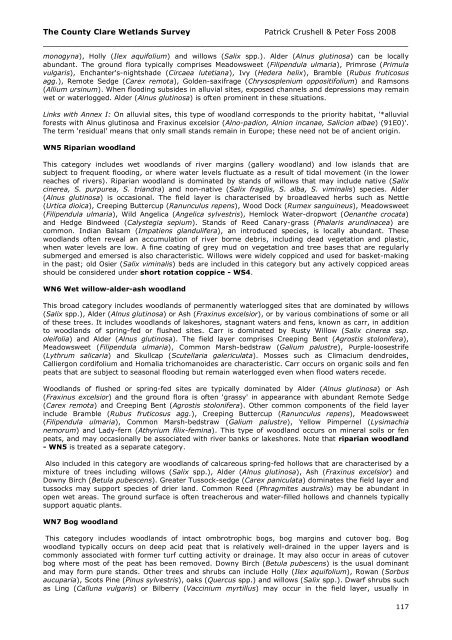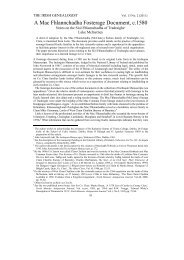Report Cover Vol I - Clare County Library
Report Cover Vol I - Clare County Library
Report Cover Vol I - Clare County Library
Create successful ePaper yourself
Turn your PDF publications into a flip-book with our unique Google optimized e-Paper software.
The <strong>County</strong> <strong>Clare</strong> Wetlands Survey Patrick Crushell & Peter Foss 2008<br />
_______________________________________________________________<br />
monogyna), Holly (Ilex aquifolium) and willows (Salix spp.). Alder (Alnus glutinosa) can be locally<br />
abundant. The ground flora typically comprises Meadowsweet (Filipendula ulmaria), Primrose (Primula<br />
vulgaris), Enchanter's-nightshade (Circaea lutetiana), Ivy (Hedera helix), Bramble (Rubus fruticosus<br />
agg.), Remote Sedge (Carex remota), Golden-saxifrage (Chrysosplenium oppositifolium) and Ramsons<br />
(Allium ursinum). When flooding subsides in alluvial sites, exposed channels and depressions may remain<br />
wet or waterlogged. Alder (Alnus glutinosa) is often prominent in these situations.<br />
Links with Annex I: On alluvial sites, this type of woodland corresponds to the priority habitat, '*alluvial<br />
forests with Alnus glutinosa and Fraxinus excelsior (Alno-padion, Alnion incanae, Salicion albae) (91E0)'.<br />
The term 'residual' means that only small stands remain in Europe; these need not be of ancient origin.<br />
WN5 Riparian woodland<br />
This category includes wet woodlands of river margins (gallery woodland) and low islands that are<br />
subject to frequent flooding, or where water levels fluctuate as a result of tidal movement (in the lower<br />
reaches of rivers). Riparian woodland is dominated by stands of willows that may include native (Salix<br />
cinerea, S. purpurea, S. triandra) and non-native (Salix fragilis, S. alba, S. viminalis) species. Alder<br />
(Alnus glutinosa) is occasional. The field layer is characterised by broadleaved herbs such as Nettle<br />
(Urtica dioica), Creeping Buttercup (Ranunculus repens), Wood Dock (Rumex sanguineus), Meadowsweet<br />
(Filipendula ulmaria), Wild Angelica (Angelica sylvestris), Hemlock Water-dropwort (Oenanthe crocata)<br />
and Hedge Bindweed (Calystegia sepium). Stands of Reed Canary-grass (Phalaris arundinacea) are<br />
common. Indian Balsam (Impatiens glandulifera), an introduced species, is locally abundant. These<br />
woodlands often reveal an accumulation of river borne debris, including dead vegetation and plastic,<br />
when water levels are low. A fine coating of grey mud on vegetation and tree bases that are regularly<br />
submerged and emersed is also characteristic. Willows were widely coppiced and used for basket-making<br />
in the past; old Osier (Salix viminalis) beds are included in this category but any actively coppiced areas<br />
should be considered under short rotation coppice - WS4.<br />
WN6 Wet willow-alder-ash woodland<br />
This broad category includes woodlands of permanently waterlogged sites that are dominated by willows<br />
(Salix spp.), Alder (Alnus glutinosa) or Ash (Fraxinus excelsior), or by various combinations of some or all<br />
of these trees. It includes woodlands of lakeshores, stagnant waters and fens, known as carr, in addition<br />
to woodlands of spring-fed or flushed sites. Carr is dominated by Rusty Willow (Salix cinerea ssp.<br />
oleifolia) and Alder (Alnus glutinosa). The field layer comprises Creeping Bent (Agrostis stolonifera),<br />
Meadowsweet (Filipendula ulmaria), Common Marsh-bedstraw (Galium palustre), Purple-loosestrife<br />
(Lythrum salicaria) and Skullcap (Scutellaria galericulata). Mosses such as Climacium dendroides,<br />
Calliergon cordifolium and Homalia trichomanoides are characteristic. Carr occurs on organic soils and fen<br />
peats that are subject to seasonal flooding but remain waterlogged even when flood waters recede.<br />
Woodlands of flushed or spring-fed sites are typically dominated by Alder (Alnus glutinosa) or Ash<br />
(Fraxinus excelsior) and the ground flora is often 'grassy' in appearance with abundant Remote Sedge<br />
(Carex remota) and Creeping Bent (Agrostis stolonifera). Other common components of the field layer<br />
include Bramble (Rubus fruticosus agg.), Creeping Buttercup (Ranunculus repens), Meadowsweet<br />
(Filipendula ulmaria), Common Marsh-bedstraw (Galium palustre), Yellow Pimpernel (Lysimachia<br />
nemorum) and Lady-fern (Athyrium filix-femina). This type of woodland occurs on mineral soils or fen<br />
peats, and may occasionally be associated with river banks or lakeshores. Note that riparian woodland<br />
- WN5 is treated as a separate category.<br />
Also included in this category are woodlands of calcareous spring-fed hollows that are characterised by a<br />
mixture of trees including willows (Salix spp.), Alder (Alnus glutinosa), Ash (Fraxinus excelsior) and<br />
Downy Birch (Betula pubescens). Greater Tussock-sedge (Carex paniculata) dominates the field layer and<br />
tussocks may support species of drier land. Common Reed (Phragmites australis) may be abundant in<br />
open wet areas. The ground surface is often treacherous and water-filled hollows and channels typically<br />
support aquatic plants.<br />
WN7 Bog woodland<br />
This category includes woodlands of intact ombrotrophic bogs, bog margins and cutover bog. Bog<br />
woodland typically occurs on deep acid peat that is relatively well-drained in the upper layers and is<br />
commonly associated with former turf cutting activity or drainage. It may also occur in areas of cutover<br />
bog where most of the peat has been removed. Downy Birch (Betula pubescens) is the usual dominant<br />
and may form pure stands. Other trees and shrubs can include Holly (Ilex aquifolium), Rowan (Sorbus<br />
aucuparia), Scots Pine (Pinus sylvestris), oaks (Quercus spp.) and willows (Salix spp.). Dwarf shrubs such<br />
as Ling (Calluna vulgaris) or Bilberry (Vaccinium myrtillus) may occur in the field layer, usually in<br />
117
















